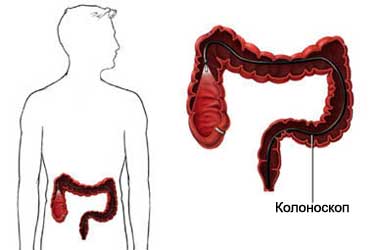Colonoscopy
Description colonoscopy
Colonoscopy – visual inspection of the rectum and colon. Inspection is carried out with a tool, called a colonoscope. The colonoscope is a flexible tube with a tiny camera on the end. This instrument allows the doctor to examine the inside of your rectum and colon.

When assigned a colonoscopy?
Colonoscopy is used to study, diagnose and treat problems in the colon. This procedure is most often done for the following reasons:
- To determine the cause of abdominal pain, bleeding from the rectum or bowel changes;
- For detection and treatment Colon Cancer and colon polyps;
- To obtain tissue samples for testing;
- To stop intestinal bleeding;
- To monitor the response to therapy, if you have inflammatory bowel disease.
Possible complications of colonoscopy
Complications are rare, but no procedure does not guarantee the absence of risk. Before, how to perform a colonoscopy, you need to know about possible complications, which may include:
- Bleeding;
- Perforation or puncture of the intestine;
Factors, that may increase the risk of complications:
- Smoking;
- Pre-existing heart or kidney disease;
- Treatment with certain medicines, including aspirin and other drugs with anticoagulant or blood diluent properties;
- Prior abdominal surgery or course radiation therapy;
- Active colitis, diverticulitis or other intestinal disease;
- Previous treatment radiation therapy.
How is colonoscopy?
Preparation for the procedure
Your doctor, probably, perform these steps::
- Will examine;
- Studying the history of the disease;
- Learn about the medication;
- Check the stool for occult blood.
Your colon must be completely clean before the procedure. Any chair, which remains in the intestine will block Review. This preparation may start several days before the procedure,. Follow your doctor's instructions, which may include any of the following ways to clean:
- Enema – fluid is introduced into the rectum, to stimulate defecation;
- Laxatives – medicines, which cause the chair;
- We need to take a clear liquid diet;
- Receive a large amount of liquid to stimulate defecation.
In the run-up procedure:
- The patient may be asked to stop taking certain medicines a week before the procedure,:
- Anti-inflammatory drugs (eg, aspirin);
- Blood thinners, such as clopidogrel or warfarin;
- Additives or vitamins, containing iron.
- The night before, you can eat a light meal. Do not eat or drink after midnight before surgery;
- If you have diabetes, you need to consult a doctor, if you need to take a dose of insulin;
- It is necessary to arrange a ride home after the procedure.
Anesthesia
The patient receives a sedative (sedative). It will help to relax. It will be a feeling of drowsiness, but the patient does not fall asleep.
Colonoscopy Procedure
You will lie on your left side with legs bent and knees pulled up to his chest. The colonoscope will be slowly inserted through the rectum into the intestine. Also through the colonoscope can be supplied air, to open a colon. A small video camera on the end of the colonoscope allows the doctor to examine the colon cover, projected on the screen.
During the procedure, can be selected tissue samples for biopsy or polyps removed.
How long will the colonoscopy?
Less than an hour.
Will it hurt?
Special cleaning solution, laxatives, and / or enemas often cause discomfort. During and after the procedure is usually no pain. The patient may feel pressure, abdominal distention, and / or convulsions due to pumping air into the colon. This discomfort will disappear after the gas. Your doctor may prescribe pain medicine to relieve discomfort.
Caring for the patient after colonoscopy
If the fabric has been removed:
- It will be sent to a lab for examination. It may take 1-2 of the week. Depending on the results obtained may be recommended other tests;
- During the first few days after the procedure may be a little bleeding.
When you return home after the procedure, Be sure to follow your doctor's instructions, which may include:
- Taking medication as directed by a doctor;
- You can resume a normal diet, unless otherwise stated Dr.;
- Sedative give you a feeling of sleepiness. Avoid driving, control equipment or make important decisions until the end of the day;
- Rest the remainder of the day.
Contact your doctor after colonoscopy
After returning home, you need to see a doctor, If the following symptoms:
- Bleeding from the rectum of a teaspoon or more of blood;
- Black, tarry stools;
- Severe abdominal pain;
- Constipation;
- Signs of infection, including fever or chills;
- Failure to pass gas or stool;
- Cough, breathlessness, chest pain, nausea and vomiting.
